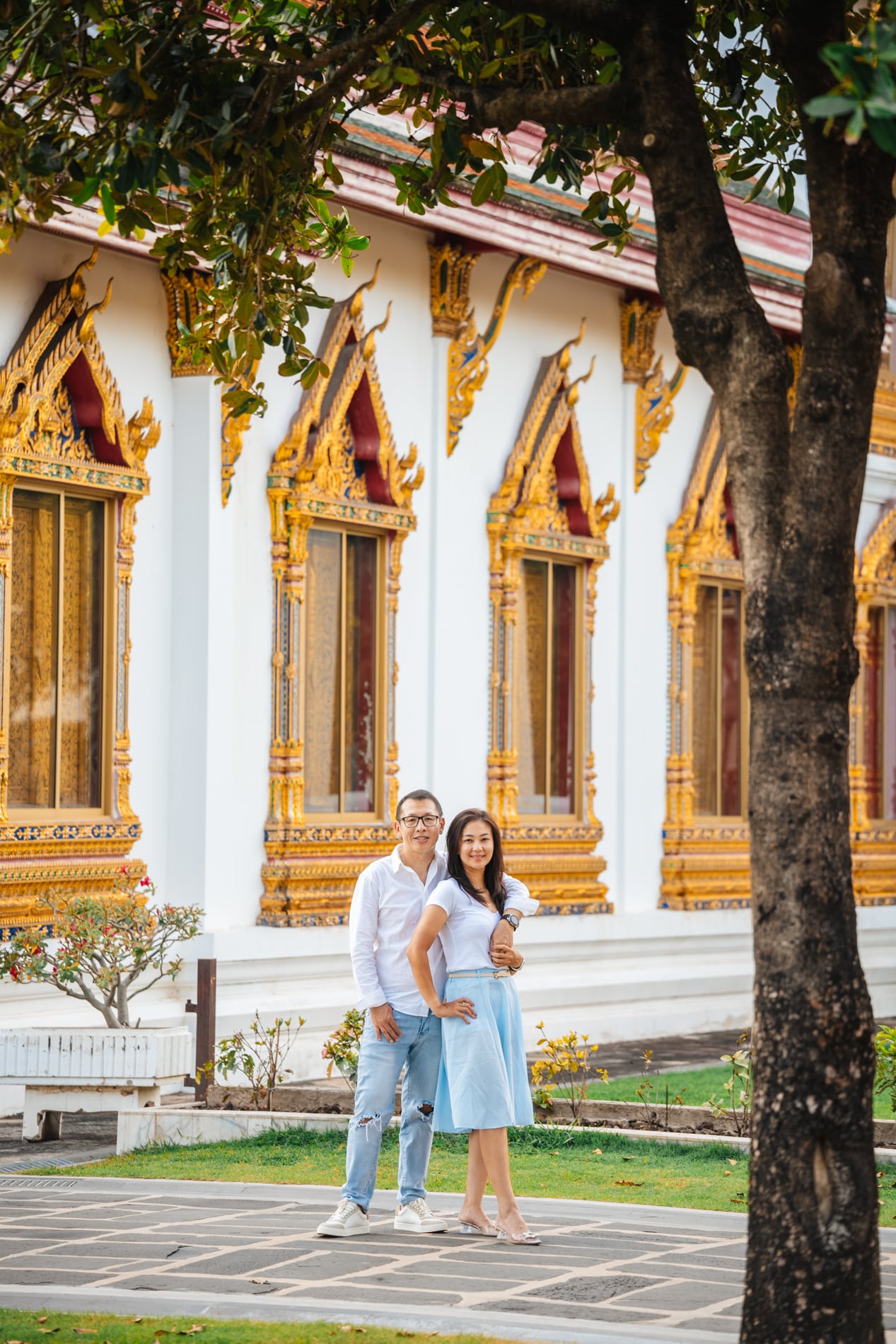As a photographer who’s spent countless hours capturing love stories against the backdrop of Bangkok’s stunning temples, I’ve come to appreciate not just their visual beauty, but the deep cultural significance they hold. These sacred spaces offer breathtaking scenery for pre-wedding shoots, but they also require a level of respect and understanding that goes beyond simply finding the perfect angle.
I remember the first time I brought a couple to Wat Pho for their pre-wedding photos. They were awestruck by the grandeur of the reclining Buddha, the intricate details of the chedis, the serenity that seemed to permeate the air despite the bustle of tourists. But as we prepared to start shooting, I noticed a hint of uncertainty in their eyes. “How do we do this respectfully?” they asked. It was a question that would shape my approach to temple shoots for years to come.
Bangkok’s temples, or ‘wats’, are not just tourist attractions or pretty backdrops. They are active places of worship, centers of community life, and repositories of Thai culture and history. When we step into these spaces with our cameras and our love stories, we’re entering a world where the ancient and the modern, the sacred and the everyday, coexist in delicate balance.
Let me take you on a journey through the dos and don’ts of temple photography, not just as a list of rules, but as a way of deepening your connection to these extraordinary places and to each other.
First and foremost, dress is paramount. I always advise my couples to think of their temple visit as attending a respected elder’s home. For women, this means shoulders and knees covered. Long skirts or palazzo pants paired with sleeved blouses are both respectful and photogenic. Men should opt for long trousers and collared shirts. I once worked with a couple who incorporated traditional Thai elements into their outfits – the bride in a long silk skirt and sabai (a cloth draped over one shoulder), the groom in a fitted linen shirt and trousers. The results were stunning – photos that honored both their love and the cultural context of our location.
But respectful dress goes beyond just covering up. It’s about understanding the spirit of modesty that temples embody. Avoid clothing with provocative images or slogans. Instead, think elegant, think understated. Some of my favorite shoots have featured couples in simple, classic attire that allowed the beauty of the temples – and their own love – to take center stage.
Footwear is another important consideration. Many temple areas require visitors to remove their shoes. I always suggest bringing a pair of slip-on shoes or sandals to make this process easier as we move between different areas. There’s something quite intimate and grounding about padding barefoot across ancient stones, feeling the history beneath your feet. I encourage couples to embrace this sensation, to let it inform their interactions with each other and the space around them.
Once properly attired, we come to behavior within the temple grounds. The key here is mindfulness – being aware of your surroundings and the other people sharing the space. Speak softly, move gently. I often start these shoots with a moment of quiet contemplation, allowing couples to center themselves and connect with the energy of the place.
Physical displays of affection should be kept minimal and tasteful. While a gentle hand hold or a soft embrace can create beautiful, emotive shots, anything more overt is best saved for other locations. I remember a shoot at Wat Arun where the couple, inspired by the temple’s association with the rising sun, chose to greet the dawn together in a respectful ‘wai’ pose. The resulting image captured not just their love for each other, but their reverence for the cultural significance of their surroundings.
When it comes to posing and composing shots, I always stress the importance of not turning our backs to Buddha images. This is considered disrespectful in Thai culture. Instead, we work with angles that allow us to incorporate these revered figures in a way that honors their presence. I’ve captured some stunning images of couples gazing up at towering Buddha statues, their expressions a mix of awe and love that speaks volumes about the power of these sacred spaces.
Interacting with monks, if they’re present, requires its own set of considerations. Women should never touch or hand anything directly to a monk – if you want to make an offering, it should be placed on a cloth for the monk to pick up. Men can interact more directly but should still maintain a respectful distance. I once photographed a beautiful moment where a couple received a blessing from a monk, the early morning light casting a golden glow over the scene. The image captured not just a picturesque moment, but a genuine connection to Thai spiritual traditions.
As we move through the temple, I always remind couples to be mindful of ongoing religious ceremonies or individuals in prayer. We might pause our shoot to allow a group of worshippers to pass, or to give space to someone deep in meditation. These moments of respect and patience often lead to the most authentic and meaningful images – couples sharing a quiet smile as they wait, or a contemplative shot as they observe the living, breathing culture around them.
Some temples have specific rules about where photography is allowed. Always check with temple authorities or look for signs indicating restricted areas. I make it a point to research each location thoroughly before a shoot, often visiting in advance to speak with temple staff and understand any particular sensitivities or special considerations.
One aspect of temple etiquette that often surprises couples is the prohibition on raised feet pointing towards Buddha images or altars. This extends to our photography – no shots with feet prominently displayed pointing at sacred objects. Instead, I encourage couples to sit cross-legged if we’re capturing seated poses, which not only respects local customs but often results in beautifully intimate, grounded images.
It’s also worth noting that some smaller or less touristy temples might not be accustomed to pre-wedding photography. In these cases, I always make a point of making a donation to the temple. It’s a way of giving back to the community that’s providing us with such a beautiful backdrop. I’ve found that this gesture of respect often opens doors, sometimes quite literally – I once had a monk offer to show us a usually closed section of a temple after observing our respectful behavior and generous donation.
As we wrap up our shoots, I always encourage couples to take a moment to reflect on the experience. Many have told me that the process of navigating temple etiquette together, of being mindful and respectful in this sacred space, has brought them closer as a couple. It’s a beautiful way to start the journey towards marriage – with reverence, cultural appreciation, and mutual support.
Ultimately, capturing pre-wedding photos in Bangkok’s temples is about more than just creating beautiful images. It’s about engaging with Thai culture in a meaningful way, about understanding and respecting the spiritual significance of these spaces. When we approach temple photography with this mindset, the results are invariably more powerful, more authentic, and more deeply connected to the spirit of Bangkok itself.
So to couples dreaming of temple pre-wedding shoots, I say this: come with open hearts and minds. Be prepared to learn, to adapt, to embrace a different way of being. Let the serenity and beauty of these sacred spaces inform your interactions with each other. And trust that by respecting the cultural etiquette of Bangkok’s temples, you’re not limiting your shoot – you’re enriching it, creating images and memories that resonate with the depth and beauty of both Thai culture and your own love story.
Remember, in the end, the most beautiful photos are those that capture not just how you look, but who you are – as individuals, as a couple, and as respectful visitors in a land of ancient wisdom and enduring spirituality. Let’s create images that you’ll treasure not just for their beauty, but for the growth, understanding, and shared experience they represent.


